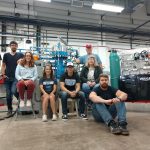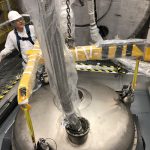World’s most sensitive underground dark matter research experiment is up and running thanks to UW–Madison contributions
By Natasha Kassulke, natasha.kassulke@wisc.edu
Nearly a mile beneath the Black Hills in a gold mine in Lead, S.D., there is a hunt underway for theoretical particles known as WIMPs (weakly interacting massive particles). But don’t let the acronym fool you.
These WIMPs are heavy hitters in the field of particle physics and the new underground detector located at the Sanford Underground Research Facility (SURF) in Lead and led by the Lawrence Berkeley National Lab (Berkeley Lab), is among our top prospects for explaining dark matter. The experiment, which the UW–Madison Physics Department and the Physical Sciences Lab (PSL) have been working on since 2012, is underground to protect it from cosmic radiation at the surface that could drown out dark matter signals.
Believed to make up nearly 80 percent of all the matter in the universe, dark matter has never been directly detected and is considered to be one of the most pressing questions in particle physics.
The SURF LUX-ZEPLIN (LZ) detector is one of only a few next-generation liquid xenon dark matter experiments in the world and, according to the project website, is at least 100 times more sensitive to finding signals from dark matter particles than its predecessor. The facility’s depth and rock stability make it ideal for sensitive experiments that need to escape cosmic rays.
The LZ collaboration includes over 35 institutions and 250 scientists and engineers from around the world. Among those engineers who have contributed a substantial number of hours are Jeff Cherwinka, LZ’s chief engineer, and Terry Benson, both mechanical engineers for the UW–Madison’s Physical Sciences Lab (PSL).
Cherwinka is not new to high energy detector design and has also worked on detectors at the Daya Bay Reactor Neutrino Experiment in China. Both Cherwinka and Benson have worked on the IceCube Neutrino Observatory project, which is located at the South Pole.
For the LZ project, Cherwinka says he has already logged in 491 days on site and drove more than 17,000 miles back and forth from South Dakota to Madison, when flying was severely limited during the height of the COVID-19 pandemic.
PSL has provided over $8M worth of effort on the LZ project, including Cherwinka and Benson’s time as engineers. Other PSL staff also have contributed through efforts at PSL in Stoughton where they conducted fabrication, manufacturing, cleaning and testing. Some also worked on site and underground in the former mine.
PSL is a research and development laboratory that provides services and highly trained staff in electrical engineering, mechanical engineering, and physics to address the unique needs of research projects of every scale and complexity. PSL has partnered with UW Madison researchers since 1967 and has evolved to where it is able to facilitate large-scale design, engineering and fabrication projects such as the LZ.

Physical Sciences Lab staff who worked on the LZ project include (pictured left to right) Iin front of a Xenon recovery compressor at PSL. Photo by Terry Benson (using a timer)
Terry Benson
Jonathan Nikoleyczik
Barb Birrittella
Lexi Sabarots
Skyler Grulke
Darrell Hamilton (Rear)
Mary Severson
Ty Vietanen
At the SURF site, Cherwinka, a 1989 UW–Madison graduate, has contributed over the last year to 3D modeling design and planning, assembly and careful placement of the detector. PSL staff, he explains, did a lot of work on the xenon circulation system.
The heart of the detector is comprised of two nested titanium tanks filled with 10 metric tons of very pure liquid xenon. Xenon, in its gas form, is one of the rarest elements in Earth’s atmosphere. LZ is designed so that if a dark matter particle collides with a xenon atom, it will produce a prompt flash of light followed by a second flash of light when the electrons produced in the liquid xenon chamber drift to its top.
One of Cherwinka’s greatest challenges with the project was the need for extreme purification within and surrounding the detector. Dust particles can be radioactive and can emit a trace amount of radon gas, creating a background in the experiment that makes it harder to detect dark matter.
To protect against stray dust particles and radon, the entire assembly process took place within the Surface Assembly Lab, a laboratory space with a radon-reduction system and a clean room outfitted specifically for the assembly. Within the clean space, strict cleanliness protocols were followed.
Workers themselves pose a contamination risk to the experiment and anyone working on the detector was required to wear full-coverage cleanroom suits and follow a two-stage gowning procedure. Every step closer to entering the clean room was held to higher cleanliness standards and required additional levels of gear.
“At times it would take a half hour to put on the clothes needed to do the work! It’s like working in many of our labs, but it’s a mile underground.” Cherwinka says. “I seem to be attracted to projects where you have to wear a lot of clothes.”
In a recent paper posted on the LZ website, researchers report that with the initial run, LZ is already the world’s most sensitive dark matter detector.
With confirmation that LZ and its systems are operating successfully, Cherwinka is confident that LZ will continue to work as it is designed to and that LZ’s explorations into uncharted territory could lead to a variety of surprising discoveries.
“We did a lot of test runs, but are now getting into the real science of the experiment, Cherwinka says. “I don’t think we could have made the detector any better and I was just so excited when we turned it on and it worked. At the end of the day, that’s what our work is all about – a bunch of people trying to do science. ”
LZ is supported by the U.S. Department of Energy, Office of Science, Office of High Energy Physics and the National Energy Research Scientific Computing Center, a DOE Office of Science user facility. LZ is also supported by the Science & Technology Facilities Council of the United Kingdom; the Portuguese Foundation for Science and Technology; and the Institute for Basic Science, Korea. Over 35 institutions of higher education and advanced research provided support to LZ. The LZ collaboration acknowledges the assistance of the Sanford Underground Research Facility.
###

